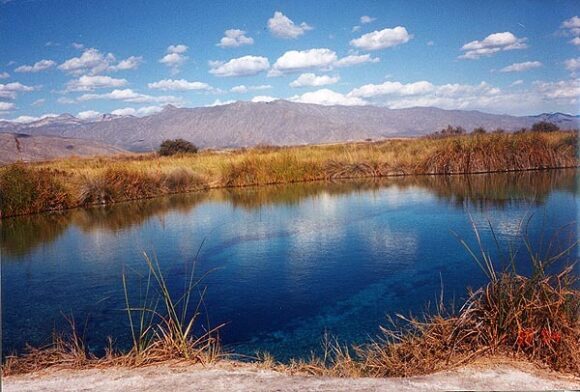Cuatro Ciénegas (“Four Marshes”) is a city and municipality in the northern border state of Coahuila. Founded in 1800, it has some historical significance, since it was the birthplace of Venustiano Carranza, Mexico’s president from 1915 to 1920.
The natural nearby “marshes” are highly unusual. Situated in an arid region (part of the Chihuahuan desert), they include several natural springs that feed more than 200 small ponds and wetlands. Some of the water supporting these unique wetlands, which cover an area of 84,400 hectares, is believed to be more than 200 million years old. The wetlands are an integral part of the UNESCO-designated Cuatro Ciénegas biosphere reserve. The reserve is home to several endemic organisms, including microorganisms such as cyanobacteria that historically helped produce oxygen for the Earth’s atmosphere. The area is considered “a living laboratory of evolution and the origin of life”.
- “Water in the Desert“, 9-minute video about the ecology of this fascinating area from the University of Texas at Austin
- Additional videos about Cuatro Ciénegas from the University of Texas at Austin
Human activities in the surrounding area have led to severe water stress on the Cuatro Ciénegas marshes. The basin’s average natural recharge rate (replenishment rate) is about 25 million cubic meters a year, but the average yearly extraction rate, almost all for agricultural use, is close to 49 million cubic meters.
Water stress may be exacerbated in coming years by climate change, which may reduce rainfall while simultaneously increasing evapotranspiration.
Scientists have also identified five particular exotic (introduced) species that pose a significant risk to the long-term quality of the Cuatro Ciénegas wetlands. Whether naturally or deliberately introduced, these five species – African jewelfish, blue tilapia, giant cane (giant reed), Guatemalan fir and tamarisk (salt cedar) – threaten to displace endemic species and change natural nutrient flows and food chains. Guatemalan fir and tamarisk soak up water as they grow, further drying out the marshes (though, eventually, when little water is left, they will die off). The blue tilapia carries parasites that can jump to local species that have no resistance to them. The African jewelfish occupies the same ecological niche as the endemic mojarra and gradually replaces it.
Mexico’s Comision Nacional de Áreas Naturales Protegidas (CONAMP), is now working with the Mexican Fund for Nature Conservation (FNCN) and the Canadian government agency Parks Canada to develop and implement a control and eradication program to tackle these five invasive species. The long-term survival of this highly unusual ecosystem may well depend on this program’s success.
Related posts:
4 Responses to “Cuatro Ciénegas wetlands threatened by five invasive species”
Sorry, the comment form is closed at this time.

I first visited Cuatro Cienegas about 16 years ago and it was almost an undiscovered paradise (or so it seemed) but until last november I hadn’t visited for almost ten years because of security concerns.
Since then there has been some investment in building raised wooden pathways and making some parts of the ecosystem more accessible and during Mexican holidays and long weekends (puentes) there is more to do in the small friendly town. The museum is worth a visit for all it has to say about it’s favourite son Venustiano Carranza, the town square is a nice traditional place to relax and it is still possible to swim in the slow meandering blue coloured river nearby.
On the down side we couldn’t find a “real” guide with any in depth knowledge of the local flora and fauna. All the guides were local high school kids with the same limited script .. however …… we found one who’s mother also cooked excellent breakfrast, lunch and dinner on her stove and served it in her kitchen and, the guide’s father could name plants and trees.
This man, without having heard of climate change or knowing of the amount of water being pumped out, was of the opinion that his teenage kids had to leave and seek work/education in a city because the land was “drying out and becoming ugly”.
Thanks for this first-hand account. It is now far more than a decade since I was last there. The lack of guides with in-depth knowledge (even of their local area) is not a surprise, but continues to disappoint me and countless other visitors who would like to be well-informed. I wonder if any tourism courses are now taking advantage of foreigners with specialist knowledge to prepare their students adequately for handling the influx of tourists that Mexico is aiming for? Years ago, in Guadalajara, I offered to accompany groups of tourism students (for free) on a “field trip” to hotels and sights in Jalisco, to give them some insights about how foreign tourists perceive places – what they would notice, the kinds of things that might concern them, and how they would decide the (perceived) quality of hotels, restaurants and services in general. None of the institutions then teaching tourism took me up on my offer!
Thanks again for your comments about Cuatro Cienegas, which are much appreciated.
Nice quick reply, Steven. Do you think your security concerns are now mostly gone?
Hi Ron. No .. I make a state by state assessment and look at the highway / roads I’d have to take and consider the likelihood of traffic volumes. From Monterrey north to Texas is a bit ..”iffy” and I avoid it if possible. If I have to go to Texas I leave early in both directions and don’t travel at night.
Going south from Monterrey I’m not so concerned about .. other than Michoacán and Guerrero.